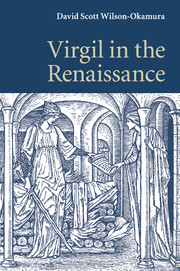Book contents
Introduction
Published online by Cambridge University Press: 05 March 2014
Summary
Do not let me hear
Of the wisdom of old men, but rather of their folly.
T. S. Eliot, East Coker
What did poets in the Renaissance know – or think they knew – about Virgil, and how did they interpret his major poems? It is an important question: for students of Spenser, Tasso, Ronsard, and Ariosto, because Virgil was the poet they all imitated; and for classicists, because this period was a pivotal one in the history of their field. The disciplines as we know them today, of archaeology, paleography, epigraphy, numismatics, and textual criticism, all date from the Renaissance, and Virgil was a test case for most of them. Piety aside, and scholarship too, what became of Virgil in the Renaissance – how he was received and how his poems were recycled – is an instance of something that occurs to every classic when it outlives its original context: when the institutions of religious and civil life from which it drew inspiration, and to which it gave substance in return, recede from it like the waters of a dying sea. The text becomes stranded. The words remain, but in the absence of institutions their meaning becomes unsponsored – until they are buoyed up once more on new tides, of new ideas and new institutions.
It is a rich tale and strange, even for one poet, and when that poet is Virgil, a central author in the European tradition, the interest – and the intricacy – are both magnified. The goal of this book is to chart the big picture: to construct a map of the whole field, which students can use and scholars can argue with. For the Middle Ages, this was done more than a hundred years ago by Domenico Comparetti. His Virgilio nel medio evo was the first major work of scholarship on Virgil’s post-classical, pre-Enlightenment reception and, when non-specialists want to gesture at the subject, it is still the one book that everyone has heard of. Published in 1872 and translated in 1895, its errors have been chastened, its omissions supplied, but it has never been replaced. There are better books, but none with the same breadth.
- Type
- Chapter
- Information
- Virgil in the Renaissance , pp. 1 - 12Publisher: Cambridge University PressPrint publication year: 2010



